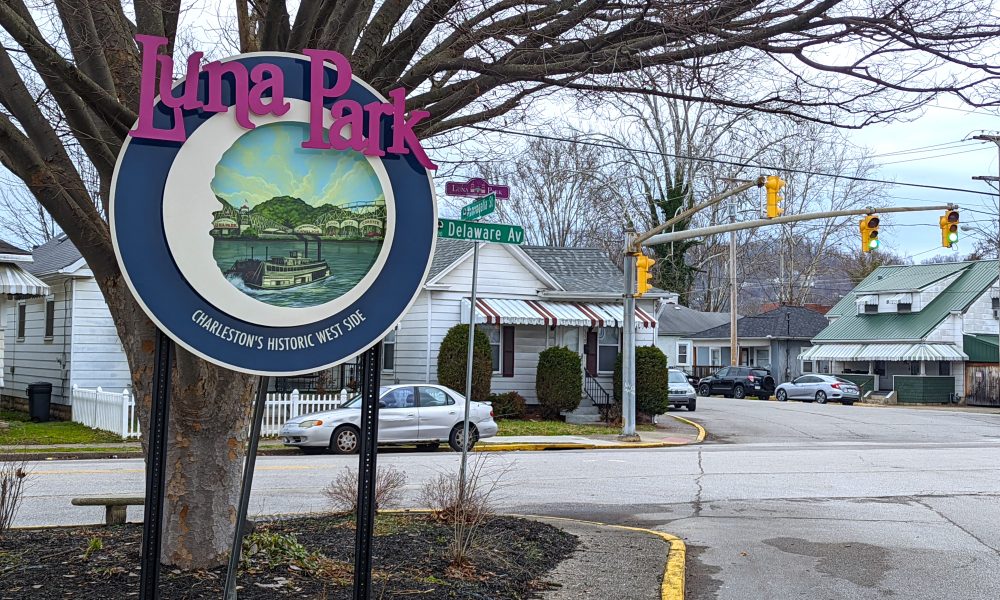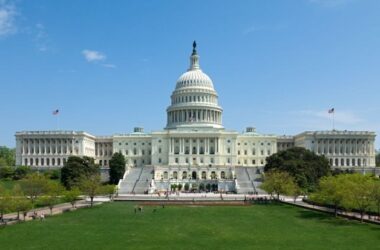WV Press Release Sharing
CHARLESTON, WV – The West Side has become a little brighter thanks to the work of the West Side Neighborhood Association’s Luna Park Historic District committee. Together in partnership with the City of Charleston and the Greater Kanawha Valley Foundation, they led the project to raise awareness about the history of the Luna Park neighborhood—most notably the site of a community amusement park open from 1912 to 1923.
The City of Charleston’s Office of Public Art led a search for artists to produce images for four “gateway signs” over five feet in diameter to mark and beautify the area. After several setbacks with the project, which began prior to the pandemic in fall of 2019, earlier this month the city installed the signs which can now be seen from the Kanawha Boulevard and Main St at the corners of the historic district where they meet Delaware Ave, Glenwood Ave, and Lovell St. Later this year, four historical interpretive panels, which will help to tell the full story of the district, will be installed.
“I’m really proud that the unique history of this area is being commemorated and I hope that it will lead to more positive changes in the community,” said Marylin McKeown, WSNA Board member and Project Manager. “I’m also grateful for the many resident volunteers that have worked on this project for over two years as well as the support we received from our city partners.”
Local residents on the committee worked hard to ensure that the images in the signs would be reflective, but not overly celebratory, of the area’s history, which includes racial exclusion and discriminatory practices. Three of the four gateway signs, which depict a vibrant glimpse into life in the Luna Park amusement park, are designed by Blake Wheeler and the fourth by Glen Brogan. Artists’ imagery includes a stern-wheeler approaching the park from the Kanawha River, a trapeze artist flying above the roller coaster, a fire breathing performance artist, and a view from the peak of the rollercoaster down over the carousel, games, and swimming pool.
Charleston Director of Public Art, Jeff Pierson designed the gateway signs template with purple “Luna Park” lettering and crescent moon border, and worked with the artists through their concepts. “The Luna Park Gateway Project was a great way to showcase local artists as we celebrate the historic West Side and look to the future of the community,” Pierson said.
There’s no concrete evidence the Luna Park Amusement Park was whites only, but historians believe this is a safe assumption given the photos available and the fact that West Virginia was a de facto Jim Crow state at the time. After a fire caused by construction on the wooden framed swimming pool damaged the park beyond repair, a housing subdivision was built with discriminatory deed restrictions much like other parts of Charleston and the nation.
Over time, racial deed restrictions were slowly overlooked, but it wasn’t until November 6, 1967 that Mayor Dodson and the city council changed their positions and passed an official city ordinance to lift the restrictions. This followed pressure and protest primarily from the African American community motivated by displacement caused by urban renewal projects. The most significant displacement resulted from the demolition of the Triangle District, Charleston’s downtown district of Black businesses and residents.
Today, Luna Park represents one of the most diverse communities in West Virginia, a state where 90% of residents identified as white in the 2020 Census. Luna Park includes portions of census tracts 7 and 8, where 55% and 44% of residents respectively identified their race as other than white alone. However, compared to the Charleston WV metro area where over 71% of residents own their homes, Luna Park residents are more likely to rent, with only 47% and 35% home owners in the two census tracts. This is a legacy of the area’s discriminatory past, and represents an opportunity for more families to build wealth through home ownership in the future. (Source: 2019 ACS 5-year estimates data profiles)
“We’re trying to figure out how to tell our stories—we want to celebrate the good, yet it’s all tied up with so much pain and suffering,” said Corey Zinn, lead creative and marketing consultant with the project. Zinn bought a home in the district in 2017, designed the newly installed street sign toppers, and produced a three part video series that tells the story of Luna Park. These videos, along with news articles and photos provide an ever-growing treasure trove of information on the area’s history on the Luna Park website. “We have to continue being fully honest about all parts of our history, so we can heal and grow together,” Zinn said.
The colorful purple and teal Luna Park Historic District street sign toppers now mark all the intersections within the district. Committee members went door to door and solicited feedback from over 163 residents which determined the final design and color scheme for the signs.
The Luna Park Historic District was listed in the National Register of Historic Places in 2012, based on the history of the Amusement Park as well as the distinctive characteristics of over 400 homes built in the 1920s after the park burned. Renowned African American Architect, John C. Norman, Sr. is among the architects that built the homes that exist there today. More information at Luna Park Historic District’s Facebook page and lunaparkwv.com






